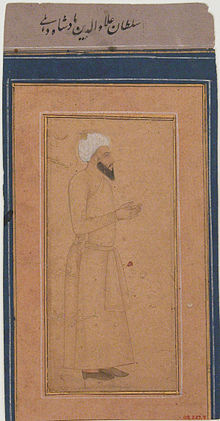
Back علاء الدين الخلجي Arabic Ала ад-Дзін Хільджы Byelorussian अलाउद्दीन ख़िलजी Bihari আলাউদ্দিন খিলজি Bengali/Bangla Muhàmmad Xah I Khalji Catalan عەلائەدین خەلجی CKB Aláuddín Chaldží Czech Ala ud-Din Khalji German Alauddin Ĥalĝi Esperanto Alaudín Spanish
| Alauddin Khalji | |||||
|---|---|---|---|---|---|
| Sultan Sikander-e-Sani (Alexander the Second) | |||||
 A 17th century portrait of Alauddin Khalji | |||||
| 13th Sultan of Delhi | |||||
| Reign | 19 July 1296–4 January 1316 | ||||
| Coronation | 21 October 1296 | ||||
| Predecessor | Jalaluddin Firuz Khalji | ||||
| Successor | Shihabuddin Omar | ||||
| Governor of Awadh | |||||
| Tenure | c. 1296–19 July 1296 | ||||
| Governor of Kara | |||||
| Tenure | c. 1266–1316 | ||||
| Predecessor | Malik Chajju | ||||
| Successor | ʿAlāʾ ul-Mulk | ||||
| Amir-i-Tuzuk | |||||
| Tenure | c. 1290–1291 | ||||
| Born | Ali Gurshasp c. 1266 | ||||
| Died | 4 January 1316 (aged 49–50) Delhi (present-day India) | ||||
| Burial | |||||
| Spouse |
| ||||
| Issue |
| ||||
| |||||
| House | Khalji dynasty | ||||
| Father | Shihabuddin Mas'ud (brother of Jalaluddin Khalji) | ||||
| Religion | Sunni Islam[2] | ||||
Alauddin Khalji (Persian: علاء الدین خلجی; r. 1296–1316), born Ali Gurshasp, was a ruler from the Khalji dynasty that ruled the Delhi Sultanate in the Indian subcontinent. Alauddin instituted a number of significant administrative changes in India, related to revenues, price controls, and society. He also successfully fended off several Mongol invasions of India.
Alauddin was a nephew and a son-in-law of his predecessor Jalaluddin. When Jalaluddin became the Sultan of Delhi after deposing the Mamluks, Alauddin was given the position of Amir-i-Tuzuk (equivalent to master of ceremonies). After suppressing a revolt against Jalaluddin, Alauddin obtained the governorship of Kara in 1291, and the governorship of Awadh in 1296, after a profitable raid on Bhilsa. In 1296, Alauddin raided Devagiri, and acquired loot to stage a successful revolt against Jalaluddin. After killing Jalaluddin, he consolidated his power in Delhi, and subjugated Jalaluddin's sons in Multan.
Over the next few years, Alauddin successfully fended off the Mongol invasions from the Chagatai Khanate, at Jaran-Manjur (1297–1298), Sivistan (1298), Kili (1299), Delhi (1303), and Amroha (1305). In 1306, his forces achieved a decisive victory against the Mongols near the Ravi riverbank, and later ransacked the Mongol territories in present-day Afghanistan. The military commanders that successfully led his army against the Mongols include Zafar Khan, Ulugh Khan, and his slave-general Malik Kafur.
Alauddin conquered the kingdoms of Gujarat (raided in 1299 and annexed in 1304), Jaisalmer (1299), Ranthambore (1301), Chittor (1303), Malwa (1305), Siwana (1308), and Jalore (1311). These victories ended several Rajput and other Hindu dynasties, including the Paramaras, the Vaghelas, the Chahamanas of Ranastambhapura and Jalore, the Rawal branch of the Guhilas, and possibly the Yajvapalas. His slave-general Malik Kafur led multiple campaigns to the south of the Vindhyas, obtaining a considerable amount of wealth from Devagiri (1308), Warangal (1310) and Dwarasamudra (1311). These victories forced the Yadava king Ramachandra, the Kakatiya king Prataparudra, and the Hoysala king Ballala III to become Alauddin's tributaries. Kafur also raided the Pandya kingdom (1311), obtaining much treasure, elephants, and horses.
During the last years of his life, Alauddin had an illness and relied on Malik Kafur to handle the administration. After his death in 1316, Malik Kafur appointed Shihabuddin, son of Alauddin and his Hindu wife Jhatyapali, as a puppet monarch. His elder son Qutbuddin Mubarak Shah seized the power shortly after his death.
- ^ Lafont, Jean-Marie & Rehana (2010). The French & Delhi : Agra, Aligarh, and Sardhana (1st ed.). New Delhi: India Research Press. p. 8. ISBN 9788183860918.
- ^ Mehta, Jaswant Lal (1979). Advanced Study in the History of Medieval India. Sterling Publishers Pvt. Ltd. p. 141. ISBN 978-81-207-0617-0.
© MMXXIII Rich X Search. We shall prevail. All rights reserved. Rich X Search